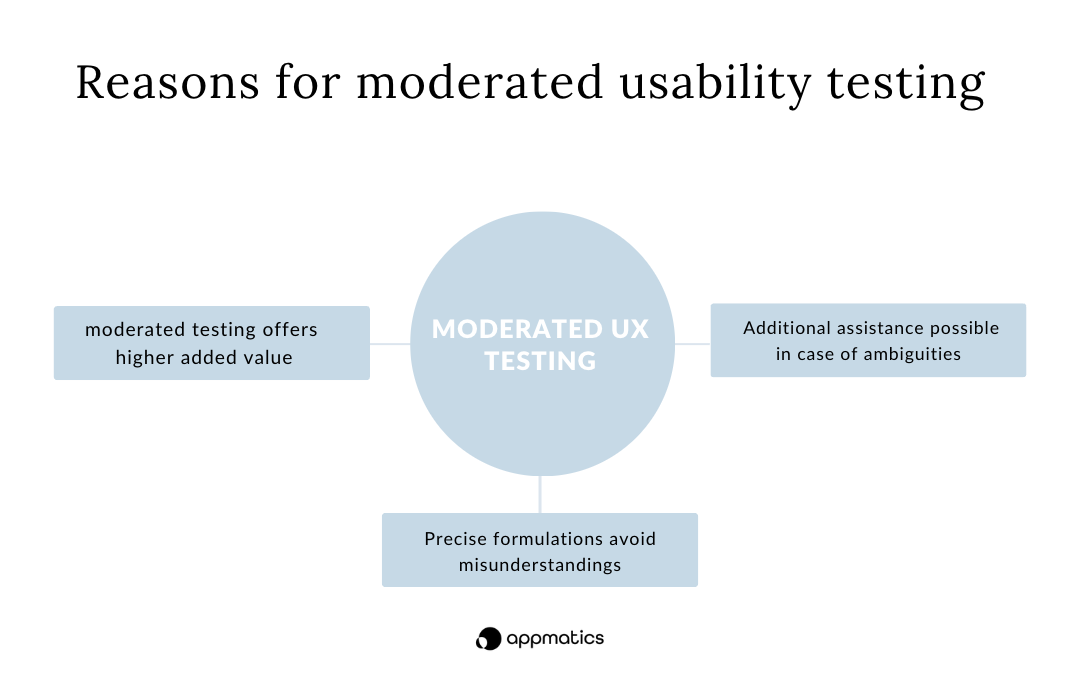Usability tests can be carried out in different ways: These include moderated and unmoderated usability tests. Our UX researchers at Appmatics have decided to offer moderated usability tests as a service to our clients. In this blog article, we explain why we have made this decision and what the difference is between moderated and unmoderated usability tests.
Moderated usability tests: What does that look like for us?
During a usability testing project, two of our Appmatics UX researchers are usually working in tandem. The testing itself takes place within the framework of individual interviews with representative average users who are selected according to the criteria of the target group of the (digital) product under investigation and invited to participate. Our UX researchers take on the role of moderators. They give the test persons tasks to solve, observe their interaction with the product and ask in-depth questions. Our UX researchers are either on-site with the test persons in a usability lab, or they conduct the interviews via screen-sharing software or a video conferencing tool.
At Appmatics, we offer both forms of moderated usability testing - remote and on-site. Which is more suitable is agreed with the client during the kick-off. Further contents of the kick-off are the clarification of questions, goals and further, for example, technical requirements for the implementation. A study concept is then drawn up on the basis of the discussed contents to be investigated. This serves as a guideline for the interview, which is adapted to the subject of the study.
During the implementation, our team in tandem ensures that the tests are not only moderated, but also simultaneously recorded and recorded live or can be followed live by our clients. On the following day, our clients also receive a link to a video library (which can be viewed for 6 months for data protection reasons) where all interviews conducted are made available for flexible viewing. In order to offer our clients the best possible experience, all videos are provided with chapter dividers, which makes it particularly easy to gain insight into the real use of their own products.
But is moderated usability testing just a simple interview? In order to carry out a successful usability test, our UX researchers do much more than just ask questions. Because the preparation and follow-up of the tests also requires a lot of know-how - on the one hand, to be able to integrate the customer's requirements as precisely as possible into the interviews and, on the other hand, to be able to analyse the results of the test and communicate them back to the customer.
What is unmoderated usability testing? How do we differ from it?
Unmoderated usability testing is usually carried out with the help of a platform or tool that structures test sessions asynchronously with the help of software. The software used provides the test persons with tasks and questions about a product to be tested, usually in written form, which are then processed and recorded. In unmoderated usability tests, no UX researchers or moderators are involved who are in direct and synchronous contact with the test persons.
Depending on the provider and the offer, a choice can be made between short quick tests and longer think-aloud tests. The test end device and the target group as well as the number of test persons can be determined on the website of the individual providers. When creating and setting up the test concept, the client is usually left to his own devices. Support from the provider is often accompanied by an additional charge.
Since no simultaneous appointments with moderators are necessary to conduct a test, the results of an unmoderated usability test can be transmitted within a short time. This means that crowd tests and international tests can also be carried out without major obstacles.

Why we chose moderated usability tests
Why did we decide to use moderated usability tests despite the advantages of unmoderated usability tests?
The strengths of the unmoderated usability test are at the same time its greatest weaknesses. On the one hand, the subject of the test must not be in a primary stage due to the absence of a moderator. When conducting the test with low and mid-fidelity prototypes, test persons often need additional assistance in order to understand or work around the limitations of an unfinished prototype - the software can only do this to a limited extent.
On the other hand, the instructions must be formulated very precisely in order to prevent misunderstandings during processing. Moderation, on the other hand, can be used to point out and clarify ambiguities in such cases. Even in the case of interesting, spontaneous events that were not recorded in the instructions, moderators have the opportunity to pick up on them ad hoc and to elaborate on them. Due to this inflexibility, an unmoderated usability test requires particularly careful planning, which can be an obstacle for the inexperienced.
But the feedback from our clients also strengthens our decision. According to our clients, who have worked with both moderated and unmoderated usability tests, the test persons of platforms are often too experienced due to the frequent participation in unmoderated usability tests, which can falsify the results of the test. Since the unmoderated test is usually not evaluated by experts and subsequent recommendations for action are missing, our clients also described the added value of the findings as lower. What is fine for testing small (partial) features is not recommended for a longer or complete flow including the cornerstones and "unhappy paths" or in the case of more complex products (such as IoT software).

Conclusion
At Appmatics, we opt for moderated usability tests to enable high-quality results for all stages of product development. We want to accompany our clients and the test persons through the entire process in the best possible way. In this way, you will receive unfiltered feedback from real users, which you will be able to implement in the best possible way thanks to our associated consulting services. Are you interested?
Then you can find out more about UX Testing here or simply make an initial appointment with us.
